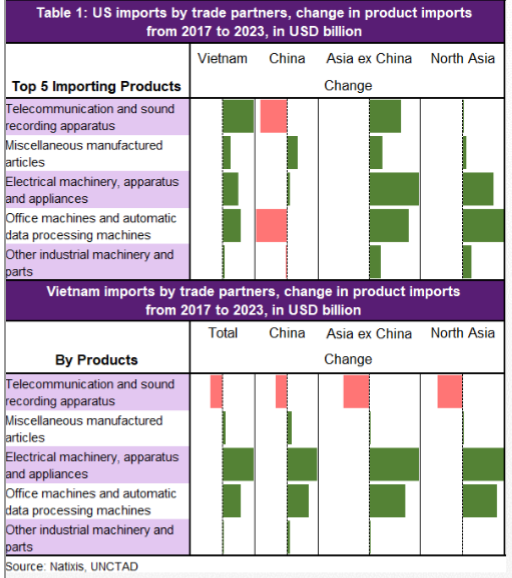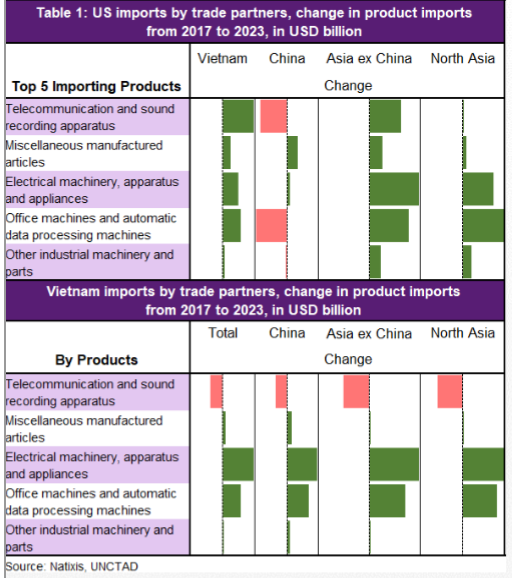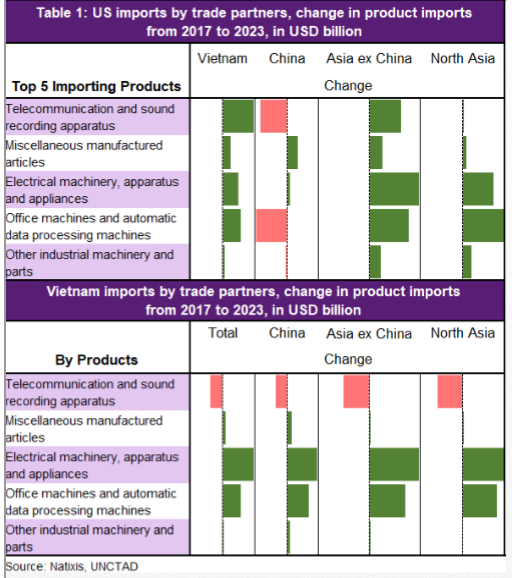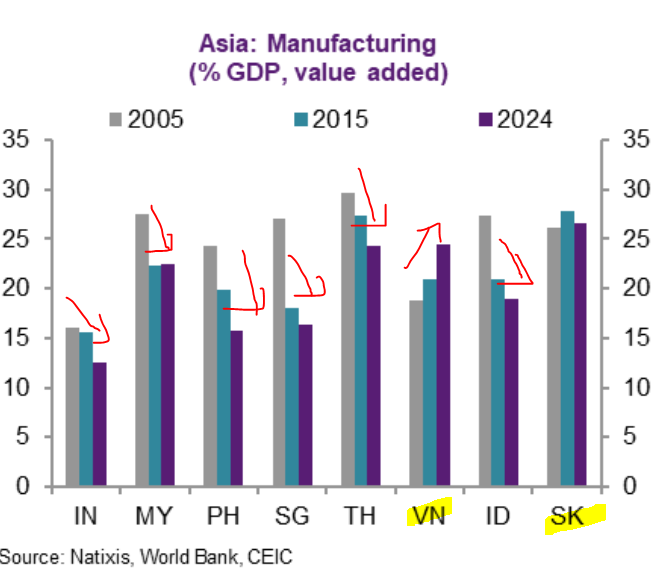Guys,
Are you ready for a Trump tariff thread and what this means? This is going to be a bit of a technical one but I'll make it easy & fun & we'll go through literature & analysis.
Let's go.
Are you ready for a Trump tariff thread and what this means? This is going to be a bit of a technical one but I'll make it easy & fun & we'll go through literature & analysis.
Let's go.
https://twitter.com/Trinhnomics/status/1014791235452588032
We start with the basics. How does tariff work? First, as you know, the US is a big free trader. Still is despite tons of tariffs on China. So goods in the US generally are tariff free to import & hence proliferation of foreign goods in the US.
But that being said, it does impose tariffs & duties. Sometimes overtly targeting a specific product to protect domestic sector due to lobbying. Anti-dumping duties is an example. A country that is not a market economy is an easy target (China, Vietnam) as u can say those countries have subsidized excessive production & hence duties.
But comes Trump. He has been consistent since the 1980s about the US trade deficit which he has railed against in public interviews and what does he do.
He started a US-China trade-war on washing machine duties.
Before we talk about what has Trump 1.0 (=first term 2017 to 2020) & Biden (2020 to 2024) done in terms of tariffs, I want to talk about the practicality of WHO PAYS FOR TARIFFS.
But that being said, it does impose tariffs & duties. Sometimes overtly targeting a specific product to protect domestic sector due to lobbying. Anti-dumping duties is an example. A country that is not a market economy is an easy target (China, Vietnam) as u can say those countries have subsidized excessive production & hence duties.
But comes Trump. He has been consistent since the 1980s about the US trade deficit which he has railed against in public interviews and what does he do.
He started a US-China trade-war on washing machine duties.
Before we talk about what has Trump 1.0 (=first term 2017 to 2020) & Biden (2020 to 2024) done in terms of tariffs, I want to talk about the practicality of WHO PAYS FOR TARIFFS.
The IMPORTERS pay for tariffs. By that, American importers pay for tariffs. So when an item say costs 100 goes to 125 because of a 25% tariffs, there are a few things that COMPANIES that import can do.
They can PASS ON that cost to CUSTOMERS (buyers of goods). They can ABSORB that cost. They can FIND A NEW SOURCE to import. Or the SELLER can make the item cost 80 or a 20% reduction of previous price to then when the seller pay 25% that is just 100 BUCKS of import costs so the SELLER ABSORBS this margin compression.
That 25% goes to the IRS as government revenue. Who pays for it? Well, it depends on who ABSORBS THAT COSTS of 25% but surely 25% tariffs happen.
They can PASS ON that cost to CUSTOMERS (buyers of goods). They can ABSORB that cost. They can FIND A NEW SOURCE to import. Or the SELLER can make the item cost 80 or a 20% reduction of previous price to then when the seller pay 25% that is just 100 BUCKS of import costs so the SELLER ABSORBS this margin compression.
That 25% goes to the IRS as government revenue. Who pays for it? Well, it depends on who ABSORBS THAT COSTS of 25% but surely 25% tariffs happen.
You may say why do you bother to talk about this but I think this point of PASS-THROUGH of tariffs matters because it impacts whether the quantity demand of the tariffed item from a country that is targeted is going to actually GO DOWN.
So let's go back to this idea of IMPORTERS paying tariffs. If price goes from 100 to 125, and the importer can import a 110 price (still higher than 100 of country X being targeted but LOWER than final costs) elsewhere, they would totally choose a new SELLER.
Elasticity of demand is the idea that when price goes up, whether quantity will fall by the same magnitude or less or more.
If you DON'T HAVE ANY OTHER SELLER & must get the goods, your elasticity of demand = 0
You will import & absorb it. But as you know, rarely do you have such an item where there is such a big moat that no one else is selling it.
So let's go back to this idea of IMPORTERS paying tariffs. If price goes from 100 to 125, and the importer can import a 110 price (still higher than 100 of country X being targeted but LOWER than final costs) elsewhere, they would totally choose a new SELLER.
Elasticity of demand is the idea that when price goes up, whether quantity will fall by the same magnitude or less or more.
If you DON'T HAVE ANY OTHER SELLER & must get the goods, your elasticity of demand = 0
You will import & absorb it. But as you know, rarely do you have such an item where there is such a big moat that no one else is selling it.
Anyway, I want to cover this point with you & I will cite this Fed paper that says ELASTICITY RISES OVER TIME.
That makes sense right. First, you are like, dude, Christmas is coming & I need that rubber wheel for my bicycle assembling & so must buy NOW irrespective of tariffs.
But over time, if TARIFFS keep going up and up and up, you are like, gosh, I must figure a way to REDUCE MY COSTS.
So the Fed has a paper that estimates that ELASTICITY OF DEMAND RISES over time. Specifically to 4 for China.
That makes sense right. First, you are like, dude, Christmas is coming & I need that rubber wheel for my bicycle assembling & so must buy NOW irrespective of tariffs.
But over time, if TARIFFS keep going up and up and up, you are like, gosh, I must figure a way to REDUCE MY COSTS.
So the Fed has a paper that estimates that ELASTICITY OF DEMAND RISES over time. Specifically to 4 for China.

So why do we care that Trump is Mister Tariff man? The US is the LARGEST importer of goods globally.
3.83trn dollars. You can find the Global South to sell your goods but a close to 4trn importing market is not one you can disregard lightly.
Btw, of that USD3.83trn imports, the US imports 501bn from China. China exports 502bn from the EU.
Let's be clear here. If the EU and the US both imports MASSIVE TARIFFS on China, this is a 1 trillion market that is hard to find elsewhere and China is trying to to protect very very hard.
So let's talk about Trump & Biden tariffs. I'll go from LATEST tariffs, which President Biden imposed on Chinese goods.
Btw chart below is US imports from China by product. You can see that it has dropped as a share of total US imports. Anyway, let's see why.
3.83trn dollars. You can find the Global South to sell your goods but a close to 4trn importing market is not one you can disregard lightly.
Btw, of that USD3.83trn imports, the US imports 501bn from China. China exports 502bn from the EU.
Let's be clear here. If the EU and the US both imports MASSIVE TARIFFS on China, this is a 1 trillion market that is hard to find elsewhere and China is trying to to protect very very hard.
So let's talk about Trump & Biden tariffs. I'll go from LATEST tariffs, which President Biden imposed on Chinese goods.
Btw chart below is US imports from China by product. You can see that it has dropped as a share of total US imports. Anyway, let's see why.

This is the latest that Pres Biden has imposed on China.
On EV, we have 100% tariff.
On semiconductor, we have 50% tariff.
On medical manufactured stuff like needles + rubber gloves, we have 50 to 100% tariffs.
Btw, there is something going on too, they are looking at closing de minimis loop hole or under 800 goods to not face tariffs.
Anyway, so the US already have a lot of tariffs on Chinese goods. Pres Biden didn't just keep Trump tariffs, he RAISED a lot of tariffs under section 301 that were reduced when Trump negotiated with China at the end of his term (remember Phase 1 and Phase 2 deals?)
nytimes.com/2024/09/13/us/…
On EV, we have 100% tariff.
On semiconductor, we have 50% tariff.
On medical manufactured stuff like needles + rubber gloves, we have 50 to 100% tariffs.
Btw, there is something going on too, they are looking at closing de minimis loop hole or under 800 goods to not face tariffs.
Anyway, so the US already have a lot of tariffs on Chinese goods. Pres Biden didn't just keep Trump tariffs, he RAISED a lot of tariffs under section 301 that were reduced when Trump negotiated with China at the end of his term (remember Phase 1 and Phase 2 deals?)
nytimes.com/2024/09/13/us/…

Anyway, most of the tariffs on Chinese goods are generally capital goods & some are now veering into consumer goods (apparel has 7.5% tariffs) & even medical gloves are now 100%.
So the tariff levels basically have basically been prohibitive (EV = 100% = prohibitive) and some zero to not so high. The trade-weighted tariff for Chinese goods is roughly 10.4% (according to our US economists).
What's the point here? Whether it's Biden or Trump, being a China hawk on trade is a bipartisan approach.
And many had hoped that Biden would put a floor on that deterioration but he had continued what Trump started, which is more curbs (tariffs + investment + sanctions) and also added extra layer of industrial policies (carrots to produce in the US & tariffs are sticks to buying from China).
So the tariff levels basically have basically been prohibitive (EV = 100% = prohibitive) and some zero to not so high. The trade-weighted tariff for Chinese goods is roughly 10.4% (according to our US economists).
What's the point here? Whether it's Biden or Trump, being a China hawk on trade is a bipartisan approach.
And many had hoped that Biden would put a floor on that deterioration but he had continued what Trump started, which is more curbs (tariffs + investment + sanctions) and also added extra layer of industrial policies (carrots to produce in the US & tariffs are sticks to buying from China).
Before I talk about the impact on the US/China/APAC trade, I want to talk about China responses since.
First, the CNY has depreciated about 15% since 2017 trade-war. Interest rates have only gone downward.
Second, China producer price index has been in decline in recent years.
Third, China has continued to subsidize supply-side growth, esp sectors targeted by the US, and not just high-end tech but expansion of energy sources.
Fourth, China has been trying to diversify out of the US (EU & rest of the world) to offset the inevitable decline in US market import through both diversifying investment & also market access.
Fifth, China has gotten closer with Russia, Iran etc.
Sixth, although already started, China started to also hedge its dependency on USD via alternative systems etc.
First, the CNY has depreciated about 15% since 2017 trade-war. Interest rates have only gone downward.
Second, China producer price index has been in decline in recent years.
Third, China has continued to subsidize supply-side growth, esp sectors targeted by the US, and not just high-end tech but expansion of energy sources.
Fourth, China has been trying to diversify out of the US (EU & rest of the world) to offset the inevitable decline in US market import through both diversifying investment & also market access.
Fifth, China has gotten closer with Russia, Iran etc.
Sixth, although already started, China started to also hedge its dependency on USD via alternative systems etc.
Despite all this, which is the depreciation of the yuan and declined PPI, which should help price competitiveness of Chinese goods (that is equivalent to say the SELLER lowering prices so that when the IMPORTER pay 25%, net net pass-through of tariff likely less than headline figure) offset tariffs, there is a noticeable DECLINE in US IMPORTS FROM CHINA.
And where items are tariffed, they are notably declined (capital goods).
So as the US continued to import more from the world, its imports from China declined for the tariff goods. For tariffed goods, that's an almost 40% decline according to the Fed.
And where items are tariffed, they are notably declined (capital goods).
So as the US continued to import more from the world, its imports from China declined for the tariff goods. For tariffed goods, that's an almost 40% decline according to the Fed.

China used to make up 23% of US imports and now it's 14%. The drop for tariffed goods are much higher. Irrespective, there is a drop.
So at a 10.4% trade weighted tariff (some items have 100% like EV), you already see a massive impact.
And that is notwithstanding China depreciating the yuan & PPI deflated, which has helped.
So at a 10.4% trade weighted tariff (some items have 100% like EV), you already see a massive impact.
And that is notwithstanding China depreciating the yuan & PPI deflated, which has helped.

Remember that I mentioned that China continued to PRODUCE LOTS OF STUFF despite of US-China tariffs.
But with demand weak onshore and PPI deflated and CPI almost non-existent, all that stuff is going to the REST OF THE WORLD.
So it's selling to the rest of the world. For example, China cannot sell EV in the US but it has then flooded the EU markets w/ Chinese EV.
Now the EU is raising tariffs but they do it pretty gently unlike Trump & Biden at 100%.
But with demand weak onshore and PPI deflated and CPI almost non-existent, all that stuff is going to the REST OF THE WORLD.
So it's selling to the rest of the world. For example, China cannot sell EV in the US but it has then flooded the EU markets w/ Chinese EV.
Now the EU is raising tariffs but they do it pretty gently unlike Trump & Biden at 100%.

Let's talk briefly about WINNERS of trade-war.
First, you may disagree & of course that is fine but I will name the following winners:
Vietnam (manufacturing)
Malaysia (manufacturing - high-tech)
India (manufacturing but mostly PORTFOLIO FLOWS)
Singapore (financial)
and to a lesser extent South Korea, Japan.
Thailand and the Philippines are kind of on the fence but I think Thailand more than PH.
First, you may disagree & of course that is fine but I will name the following winners:
Vietnam (manufacturing)
Malaysia (manufacturing - high-tech)
India (manufacturing but mostly PORTFOLIO FLOWS)
Singapore (financial)
and to a lesser extent South Korea, Japan.
Thailand and the Philippines are kind of on the fence but I think Thailand more than PH.

Vietnam is one of the few countries that has managed to raise both exports to the US and also China.
In Asia, all countries have managed to raise their exports to the US except Indonesia.
Vietnam is interesting because it sticks out like a sore thumb of how exposed it is via exports to the US.
Many people accuse that MOST TRADE VIA VIETNAM IS JUST REROUTING.
How true is that?
In Asia, all countries have managed to raise their exports to the US except Indonesia.
Vietnam is interesting because it sticks out like a sore thumb of how exposed it is via exports to the US.
Many people accuse that MOST TRADE VIA VIETNAM IS JUST REROUTING.
How true is that?

First, you should know that it can't be all rerouting because investment landscape has changed. As time goes by, companies don't just ABSORB HIGHER TARIFFS, THEY FIND CHEAPER ALTERNATIVES.
And you can say China is cheaper NO MATTER WHAT. What if TARIFFS KEEP GOING UP?
It can't be that cheap. You know that because Chinese EV disappeared from the US with 100% tariffs. Anyway, FDI inflows into ASEAN surpassed China.
And not just from Western and North Asians like South Korea and Japan and Taiwan but also by China.
And you can say China is cheaper NO MATTER WHAT. What if TARIFFS KEEP GOING UP?
It can't be that cheap. You know that because Chinese EV disappeared from the US with 100% tariffs. Anyway, FDI inflows into ASEAN surpassed China.
And not just from Western and North Asians like South Korea and Japan and Taiwan but also by China.

There is a paper by HBS on how much rerouting is really happening in Vietnam (link below).
The answer is that at the product-level, it's about 16.1% in 2021. And at the firm level, it's about 1.8%.
Either way, the point is to say that while rerouting has increased since tariffs on China, it's not as big as you think.
WHAT IS REROUTING? It is when there is ZERO-VALUE ADD. Like you don't even assemble in Vietnam.
If a company imports Chinese intermediates to then assemble in Vietnam then that is not rerouting.
Cool paper. Read it!
hbs.edu/ris/Publicatio…
The answer is that at the product-level, it's about 16.1% in 2021. And at the firm level, it's about 1.8%.
Either way, the point is to say that while rerouting has increased since tariffs on China, it's not as big as you think.
WHAT IS REROUTING? It is when there is ZERO-VALUE ADD. Like you don't even assemble in Vietnam.
If a company imports Chinese intermediates to then assemble in Vietnam then that is not rerouting.
Cool paper. Read it!
hbs.edu/ris/Publicatio…
Sorry, this thread is getting long.
Shall I show you my calculation of IMPACT OF TARIFFS ON CHINA/VIETNAM ETC? :-)
Shall I show you my calculation of IMPACT OF TARIFFS ON CHINA/VIETNAM ETC? :-)
Thread continues tomorrow & next week I am in Paris and Milan. Talk soon tomorrow on what happens next!!!
• • •
Missing some Tweet in this thread? You can try to
force a refresh









